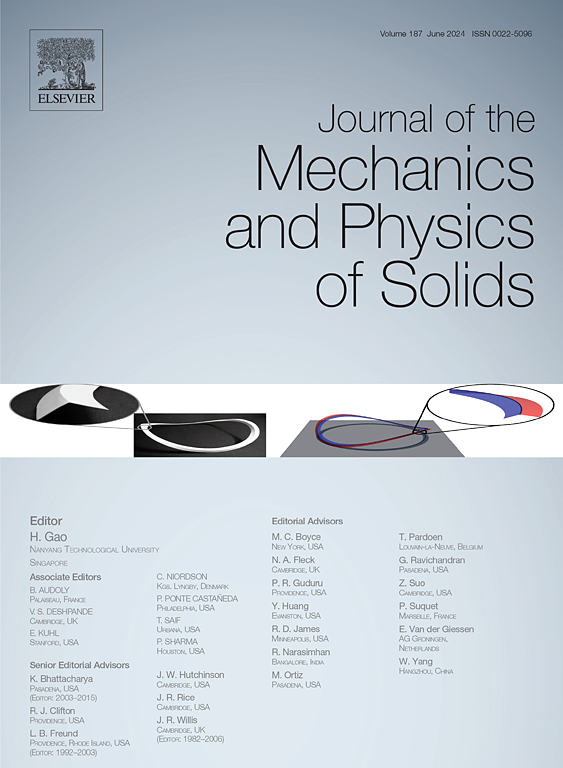Toughening mechanism of macroscale heterogeneous soft materials: a systematic study from the perspective of energy release rate
IF 6
2区 工程技术
Q2 MATERIALS SCIENCE, MULTIDISCIPLINARY
引用次数: 0
Abstract
Due to their enhanced fracture and fatigue resistance, macroscale heterogeneous soft materials consisting of alternating hard/soft phases have become increasingly prevalent in a wide range of applications. Despite their widespread use and apparent advantages, a comprehensive and precise understanding of the toughening mechanisms behind them remains elusive. Here, we systematically study the fracture mechanics of hyperelastic bi-material sheets (i.e., the basic building block of macroscale heterogeneous soft materials) through a combination of experiments, numerical calculation, and analytical analysis. First, employing heterogeneous PAAm hydrogels as a model system, we experimentally observe the hindering effect of the bi-material interface on the crack propagation from the soft phase into the hard phase, and identify the toughening rule of macroscale heterogeneous soft materials – the increase in the shear modulus contrast between the soft and hard phases leads to a substantial enhancement in the stretch at break of pre-cut heterogeneous soft materials. Second, through finite element calculations, we uncover the toughening mechanism of macroscale heterogeneous soft materials from the perspective of energy release rate: when the soft-phase crack propagates close to the soft-hard interface, the energy release rate rapidly plummets, and the reduction in the energy release rate is more obvious with the increase of the shear modulus contrast between the soft and hard phases, which plays a pivotal role in toughening heterogeneous soft materials. Lastly, an analytical fracture theory from the perspective of crack-tip deformation is derived for macroscale heterogeneous soft materials. By comparing the measured/calculated stretches at break from experiments, finite element calculation, and the analytical model, we reveal the precision, advantage and depth of understanding the toughening mechanism of macroscale heterogeneous soft materials from the perspective of energy release rate. The findings are applicable to a wide variety of hyperelastic soft materials, including biological materials, hydrogels and elastomers, offering valuable insights into the design of heterogeneous soft materials with superior mechanical properties.
宏观非均质软材料的增韧机理:从能量释放率角度的系统研究
由于具有较强的抗断裂和抗疲劳性能,由硬/软相间组成的宏观非均质软材料在广泛的应用中越来越普遍。尽管它们的广泛使用和明显的优势,但对其背后的增韧机制的全面和精确的理解仍然是难以捉摸的。本文通过实验、数值计算和分析相结合的方法,系统地研究了超弹性双材料片材(即宏观非均质软材料的基本组成部分)的断裂力学。首先,以非均相PAAm水凝胶为模型体系,实验观察了双材料界面对裂纹由软相向硬相扩展的阻碍作用,确定了宏观尺度非均质软材料的增韧规律——软、硬两相剪切模量对比的增加导致预切非均质软材料断裂拉伸的大幅增强。其次,通过有限元计算,从能量释放率的角度揭示了宏观尺度非均质软材料的增韧机理:当软相裂纹向软硬界面附近扩展时,能量释放率迅速下降,且随着软、硬相剪切模量对比的增大,能量释放率的降低更为明显,对非均质软材料的增韧起着举足轻重的作用。最后,从裂纹尖端变形的角度推导了宏观非均质软质材料的解析断裂理论。通过对比实验、有限元计算和分析模型的断裂拉伸实测值和计算值,揭示了从能量释放率角度理解宏观非均质软质材料增韧机理的准确性、优越性和深度。这些发现适用于各种超弹性软材料,包括生物材料、水凝胶和弹性体,为设计具有优越机械性能的非均质软材料提供了有价值的见解。
本文章由计算机程序翻译,如有差异,请以英文原文为准。
求助全文
约1分钟内获得全文
求助全文
来源期刊
CiteScore
9.80
自引率
9.40%
发文量
276
审稿时长
52 days
期刊介绍:
The aim of Journal of The Mechanics and Physics of Solids is to publish research of the highest quality and of lasting significance on the mechanics of solids. The scope is broad, from fundamental concepts in mechanics to the analysis of novel phenomena and applications. Solids are interpreted broadly to include both hard and soft materials as well as natural and synthetic structures. The approach can be theoretical, experimental or computational.This research activity sits within engineering science and the allied areas of applied mathematics, materials science, bio-mechanics, applied physics, and geophysics.
The Journal was founded in 1952 by Rodney Hill, who was its Editor-in-Chief until 1968. The topics of interest to the Journal evolve with developments in the subject but its basic ethos remains the same: to publish research of the highest quality relating to the mechanics of solids. Thus, emphasis is placed on the development of fundamental concepts of mechanics and novel applications of these concepts based on theoretical, experimental or computational approaches, drawing upon the various branches of engineering science and the allied areas within applied mathematics, materials science, structural engineering, applied physics, and geophysics.
The main purpose of the Journal is to foster scientific understanding of the processes of deformation and mechanical failure of all solid materials, both technological and natural, and the connections between these processes and their underlying physical mechanisms. In this sense, the content of the Journal should reflect the current state of the discipline in analysis, experimental observation, and numerical simulation. In the interest of achieving this goal, authors are encouraged to consider the significance of their contributions for the field of mechanics and the implications of their results, in addition to describing the details of their work.

 求助内容:
求助内容: 应助结果提醒方式:
应助结果提醒方式:


